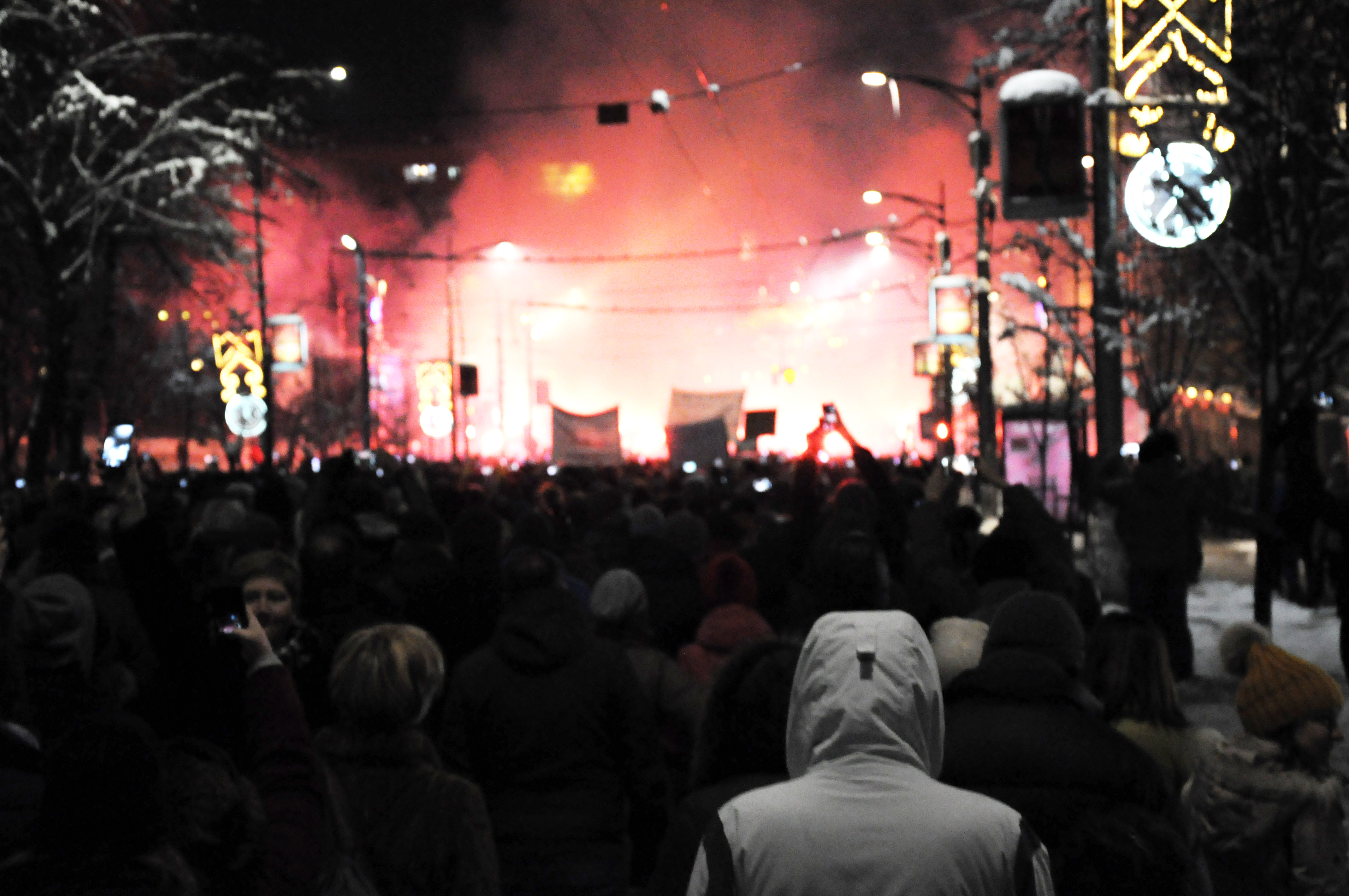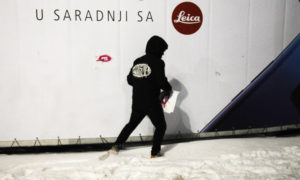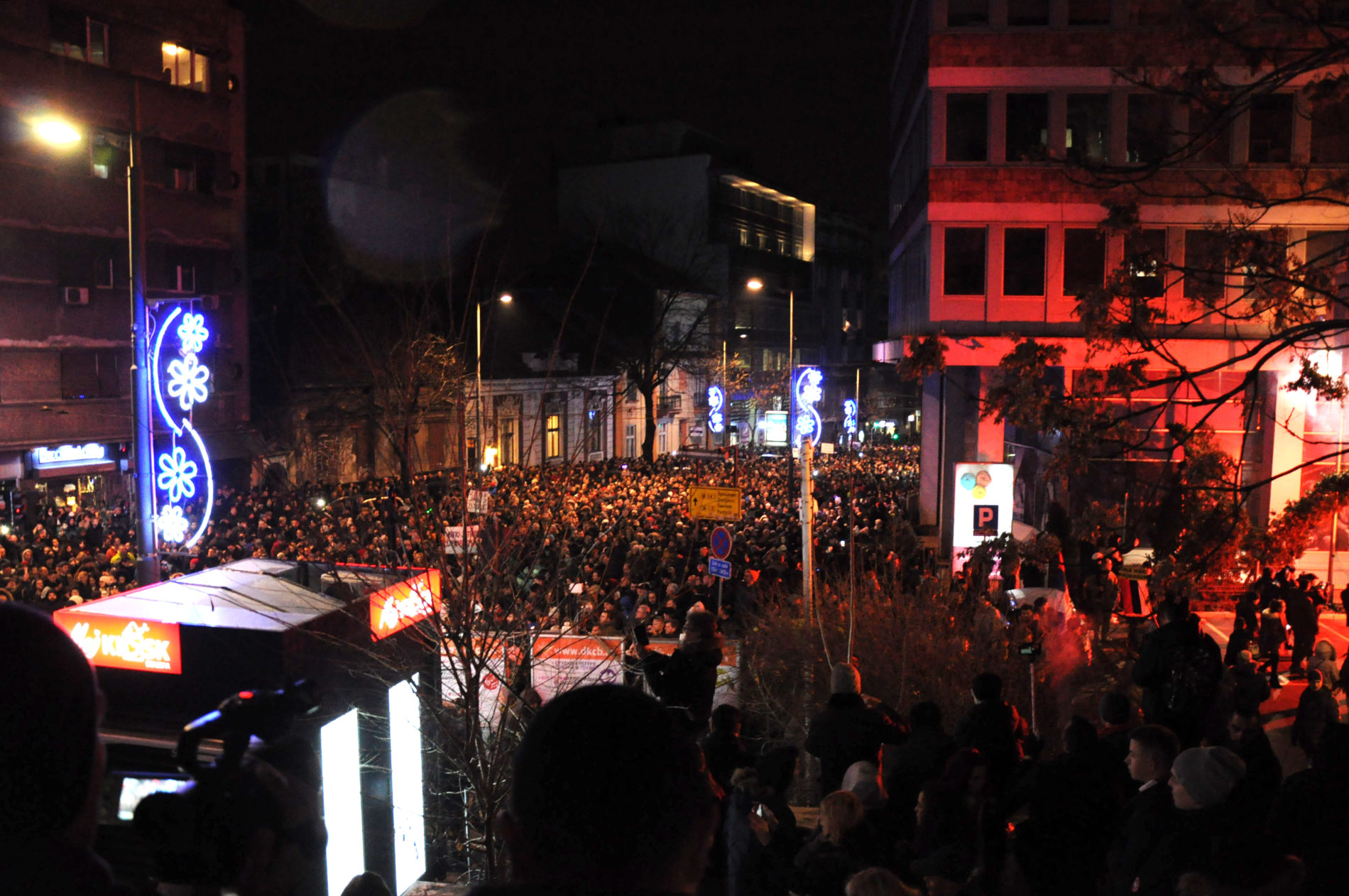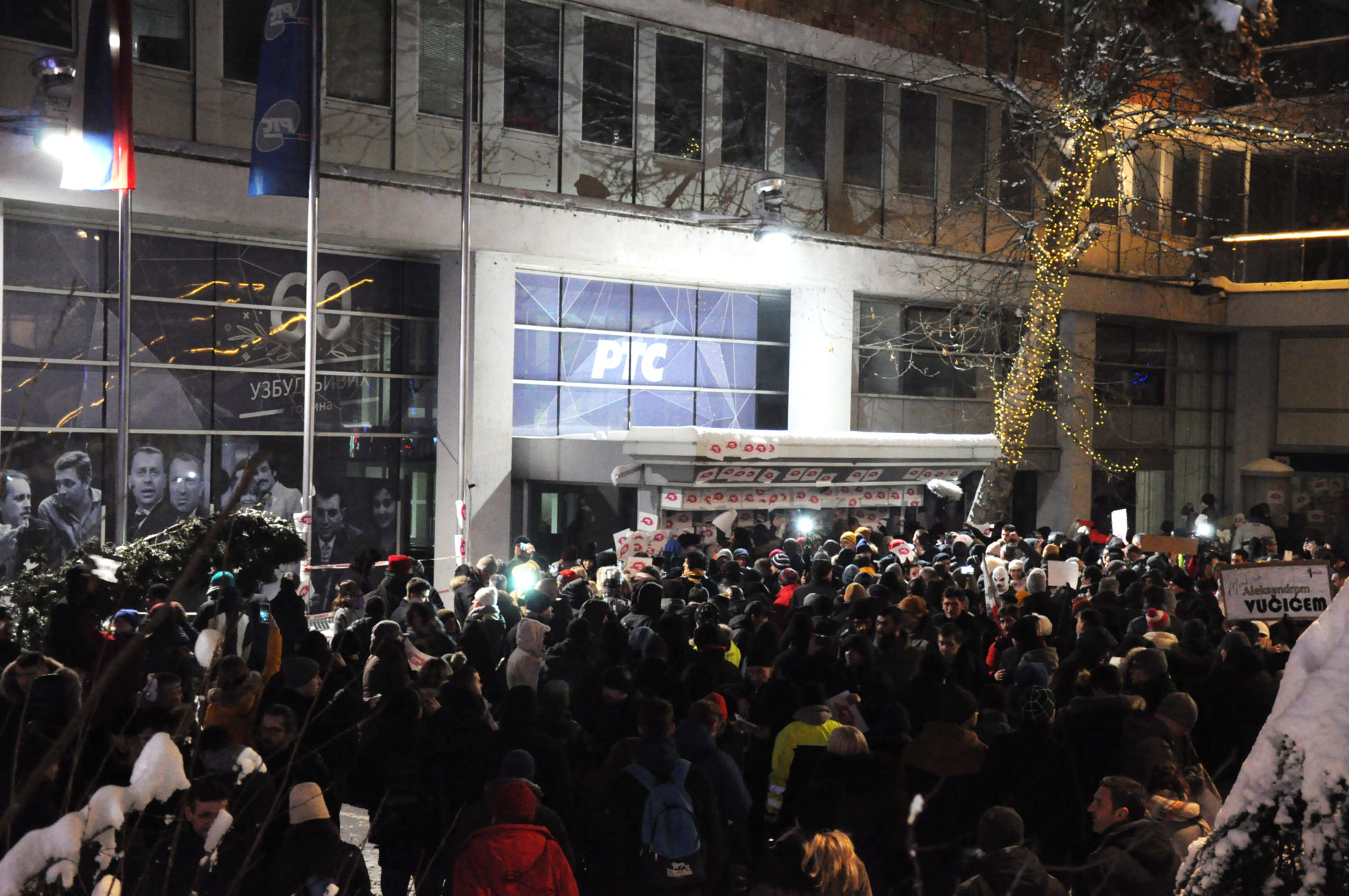Prone to Protest
Belgrade is no stranger to the sensation of tens and hundreds of thousands of feet walking and running and protesting over its asphalt grounds. In fact, 2019 marks the 130th anniversary of the city’s first documented protest in 1889.
Countless protests have been written in the city’s history since then, from those in the inter-war period — of which the Belgrade University alone organized over 80 — to the Yugoslav Coup D’État in 1941, the anti-government and anti-war demonstrations in 1991 and 1992 and those opposing the ruling party and its electoral fraud in 1996-97.
But perhaps the most iconic protest in Serbia’s recent history, familiar to many as the October 5 Revolution, took place on the day implied by its name in the year 2000.
Aiming for Slobodan Milošević, president of the Federal Republic of Yugoslavia at the time, to admit defeat at the elections held two weeks earlier, elections that yielded controversial results which had allowed him to claim necessity for a second round, hundreds of thousands of people gathered in the city center for a day-long protest.
The Parliament was eventually entered and the building of Radio Television of Serbia (RTS) — the national television at the time largely associated with Milošević — was set on fire. The following day Milošević appeared on television and admitted defeat.
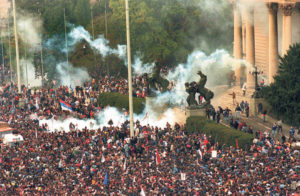
Many things have changed since October 2000 — and in the realm of media particularly. The internet, until then available only to a fraction of the worldwide population (5.8 percent, according to internetworldstats.com) and an even smaller segment of the Serbian population, has become widely accessible. Our mobile technology became more sophisticated, our devices longer and wider, thinner and smarter. We now buy less newspapers and watch less television. We have social and streaming networks and with them, fundamentally new ways of acquiring news and savoring in entertainment.
Everything about these technological advancements implies that their effects on the media could be little but democratizing, yet the shadow of media oppression currently cast over Serbian citizens stands as one of the main reasons the country’s dilapidated streets are now feeling the most massive protests since Oct. 5, 2000.
Against Dictatorship
Every protest begins with dissatisfaction. Though one could say that the flame of dissatisfaction of Serbian people over the past two decades has never truly stopped burning, a slight digression to the summer of 2017 and the first full-scale public display of this discontent — a series of protests against the then just elected president — might help with understanding the dissatisfaction of today.
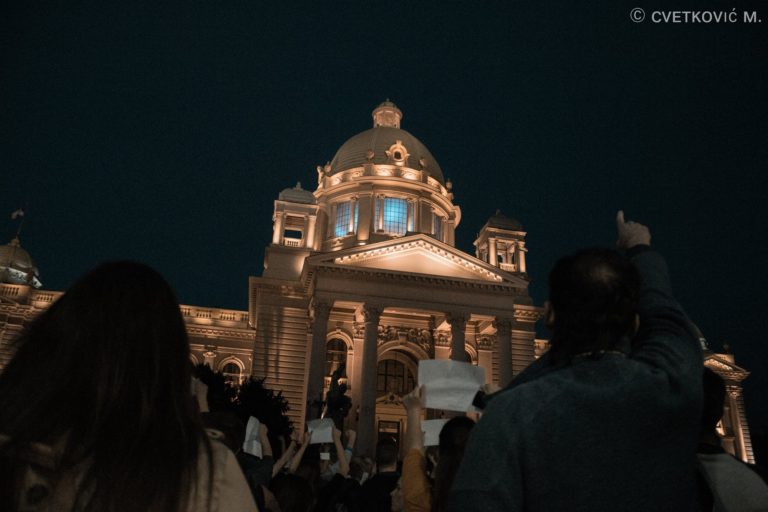
Under the slogan “Against Dictatorship,” these protests swamped the streets of Belgrade on the day succeeding the elections that would make Aleksandar Vučić the president of Serbia. They were organized apolitically and via Facebook.
By that point, Vučić had already been in the government for five years. He served two terms as Prime Minister and one, prior to the two, as Deputy Prime Minister. Public opinion about him was already well formed and so was the idea that he enjoyed influence over the vast majority of the local media.
This in itself wouldn’t necessarily have been enough to spark protests of such a scale, certainly not without the presence of deep overall social and economic dissatisfaction as well as other symptoms of autocratic rule, but the intolerable inequality of the candidates’ representations in the media during the pre-election campaigns and Vučić’s ultimate victory were perceived to have crossed the line.
According to an analysis of the election campaigns conducted by the Novi Sad School of Journalism, Pink television, arguably the channel with the highest observance ratings in the nation, showed 17,000 seconds of Vučić in their news programs during the pre-election period. The candidate with the second highest air time on this television had 65 seconds — 262 times less than Vučić.
Similarly, not one other candidate had given a direct statement on this channel within the two weeks preceding the elections, while only of the remaining TV networks, N1, had given what was considered to be equal representation to all candidates. This network has no national coverage and is only available to those with cable television.

As for the newspapers, the Centre for Research, Transparency and Accountability (CRTA) followed eight of the highest selling newspaper publishers for 45 days prior to the elections. Their results, published as part of their “Citizens on Watch” report, claim that, out of the 342 cover pages of these eight publishers over that period of time, 73 percent (251 cover pages) included politicians and were directly or indirectly related to the elections. Of those 251, Vučić was featured on 147.
Given a victory under such circumstances, the people’s urge to crowd the streets and protest on the day after the election results in 2017 appears to have come as just about natural. Main motives, like in Milošević’s time to which today’s state of media affairs is often compared, were the inadequacy of media freedom and the accusations of electoral fraud on behalf of Vučić’s party.
Half-way into the two weeks of daily protesting, the people started coming up with demands. But as the protests were organized independently and spontaneously, and as their organizers, aiming to keep them that way, refused to cooperate with any political party, the emerging demands by different groups of protestors appeared to lack consistency and unity. New sets of demands kept arising by new, independent groups, and this made it difficult for the public to focus on one particular set of demands.
At the time, it was believed that it was exactly the protestors’ disassociation to any party, the absence of an official political leader and the underlying implication that the protests were the people’s and no one else’s, which had been their greatest asset.
But as the deadline for meeting their demands arrived with none of them having been met, and as the protestors’ enthusiasm and the protests themselves began dying out following the Easter holiday break, many now believe that their greatest asset in reality backfired; that the authenticity of independently organized protests made it easier for the ruling regime and the local media to market them as frivolous, impulsive and, above all, aimless — when and if they actually found the protests newsworthy (many of the local media hadn’t reported on them at all).
Stop to the Bloody Shirts
Much has happened in Serbia under the rule of Aleksandar Vučić between his election as president in 2017 and today. Much has happened and yet, so little changed.
One of the widely discussed events was an investment of 1.8 million euros into the renovation of Belgrade’s busiest roundabout, now turned into a colorful, musical fountain that plays six songs all year round. Many other reconstructions of Belgrade’s center areas have begun, too, some of which were completed, and an 83,000 euros worth Christmas tree was installed in the city center in December 2017.
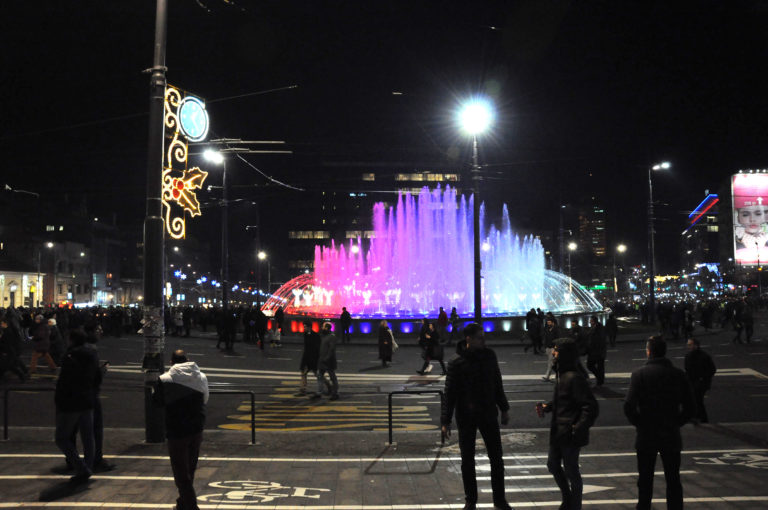
According to an article published by Financesonline, this purchase made Belgrade’s taxpayers the involuntary owners of the 10th most expensive Christmas tree in the world. But perhaps even more alarming were the Winter 2018 Christmas decorations, installed at 49 locations in mid-September when the outside temperature was 30 degrees Celsius thanks to a budget of 2.87 million euros.
Compared to 2017, this budget — financed atypically for a European country by the taxpayers — had increased by 40 percent. The justification was that the decorations would attract tourists and that they would ultimately yield a high return on investment, though no research of such a hypothesis has ever been presented.
Other than investments such as these, perceived as rather controversial by the general public, most of Serbia’s fundamental socio-economic issues seem to have remained intact, while some, like media oppression, have gotten worse.
In their 2018 Freedom in the World report, U.S.-based watchdog organization Freedom House gave Serbia a downward trend arrow “due to Vučić’s continued consolidation of power, including through opaque party financing methods, politicization of law enforcement, and attempts to undermine critical journalists with financial investigations and smears in government-friendly media.”
Besides these government-friendly media becoming all the more government-friendly, another reason the Serbian public is concerned and dissatisfied to the degree of protesting in numbers last seen 19 years ago is that these media are also growing in numbers.
There are seven television channels with national coverage in Serbia. Three of them (RTS 1, RTS2 and RTS 3) belong to RTS, the public broadcaster believed to be heavily influenced by Vučić. Another two, Pink and Happy, also have shady ties to the president. According to the Center for Investigative Journalism of Serbia (CINS), Pink received at least 7 million euros in government loans between 2014 and 2016. At the time one frequently exchanged joke on the Serbian streets was that Pink television introduced a new channel: Pink Vučić.
The remaining two TV networks with national coverage, O2 and Prva, were acquired in December 2018 by the former owner of a cable company called Kopernikus, which had been sold to the largest public telecommunication operator in the country only a month earlier for a digit well above its estimated value. The brother of O2 and Prva’s new owner is a trustee of the ruling party.
The public outrage caused by this transaction, however, and its consequential insinuation that Vučić now had access to all television networks with national coverage were just one color of the greater rage.
Another, more important side to the outrage in terms of the current protests were the assaults on the regime’s ideological opponents, on journalists and other media representatives — assaults that keep growing in number no less than in radicality. In their project “Database of Assaults on Journalists,” Independent Journalists’ Association of Serbia claims that there have been 103 assaults on journalists in 2018, most in the shape of verbal threats or pressure, seven of them physical.
In no year over the past decade have there been that many.
— Levica Srbije #mSRB_ (@LevicaSrbije) November 23, 2018
Furthermore, the leader of the Civic Initiative “Freedom, Democracy, Justice,” Oliver Ivanovic, was assassinated in January 2018. Borko Stefanović, the leader of a Serbian opposition party “Levica Srbije,” was assaulted and beaten along with two other activists by a group of armed men at one opposition meeting in Kruševac in November 2018. In December, the house of one very journalist, Milan Jovanović, was burned to the ground.
Suspects were arrested in all three cases, but the public, displeased, disproving and interested in those who ordered the crimes rather than in their executors, took it to the streets.
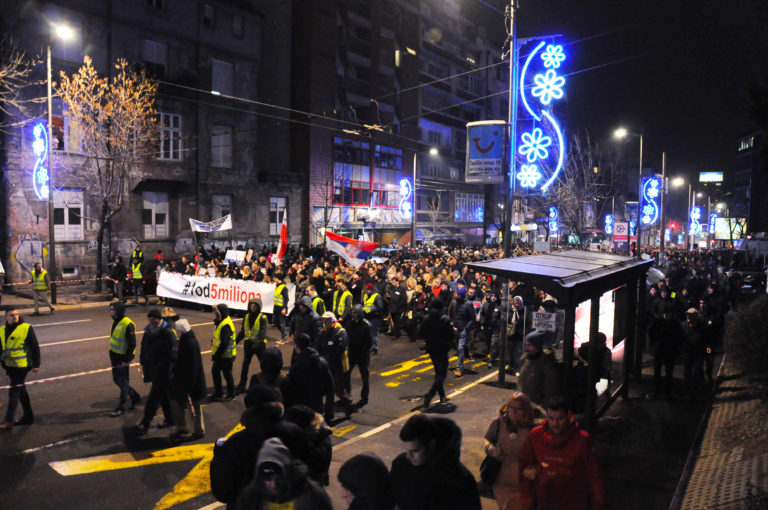
The first protest in 2018 started in Kruševac, the city of the attack on Borko Stefanović, exactly a week after it had taken place. It was called “Stop to the Bloody Shirts.”
Already the following weekend, on Dec. 8, 2018, the protest spread to Belgrade and other major cities in Serbia, from where they’ve continued, on a weekly basis, to this day. The demand in focus at the beginning was for the violence to stop.
1 in 5 Million
Whilst most of the local media made little attempts at reporting on this on either the day of the protest or the following, one particular report appeared that had ignited a nation-wide spree of furious and ironic social media activity.
A reporter until then entirely foreign to the Serbian public appeared on live television approximately one hour after the protest had ended. Standing at the by then empty square from which the protestors had begun their march, she reported that a “really small number of people gathered, much smaller than expected,” that the protests were “of course” financed by an opposition leader and that the pensioners from the city center complained to have received SMS texts from one opposition leader inviting them to attend the protests.
In distinctly unprofessional language, tone and manner, the reporter concluded, “As I said, the protest is organized against violence under the slogan ‘Stop to the Bloody Shirts,’ which shows great, great hypocrisy because it is exactly those people who organized the protest who are advocating lynching, rape, violence — and we find that very, very, very hypocritical.”
And this — attacking the integrity of the protestors, their motives and personalities — was to remain the ruling regime’s strategy for the rest of the protests.
On Dec. 9, the day after the first massive protest of 2018, President Aleksandar Vučić addressed the protestors publicly: “You can walk as long as you want, I won’t fulfill a single demand. Not even if there’s five million of you.”
Since then the protests became known by the name, “1 in 5 Million.”
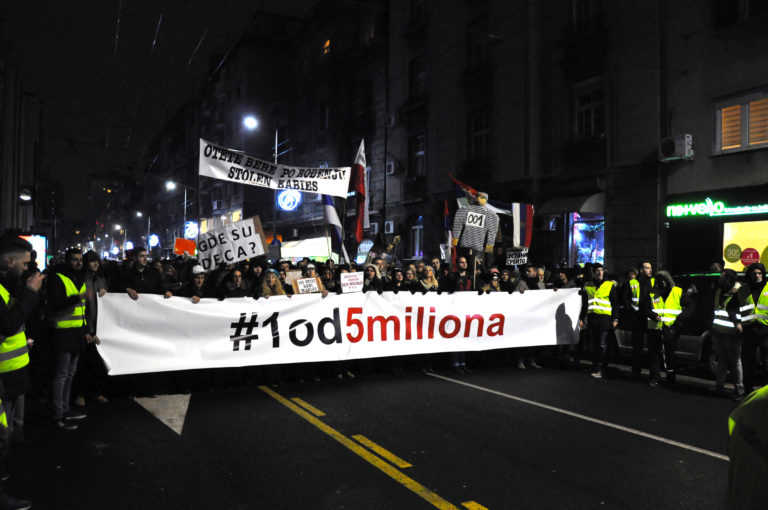
Every Saturday between Dec. 8, 2018, and today people in Belgrade have been gathering at the same time and at the same spot for a peaceful march of dissatisfaction along an always slightly modified path through the city’s widest streets. Every new protest appeared more massive than the last and, as time went by and as new events kept unfolding, new demands kept being added, too.
These protests have either really begun independently of any opposition party or only appear to have begun so because whoever was financing them preferred to stay in the dark. If an opposition party indeed stands behind them, which every member of Vučić’s party and the local media insist on and the protestors neglect, chances are that they’re not claiming credit because of the public’s general antipathy to them. Either way, with the opposition’s backing or without, uniting the people’s demands into one set once again proved a challenging task for the organizers.
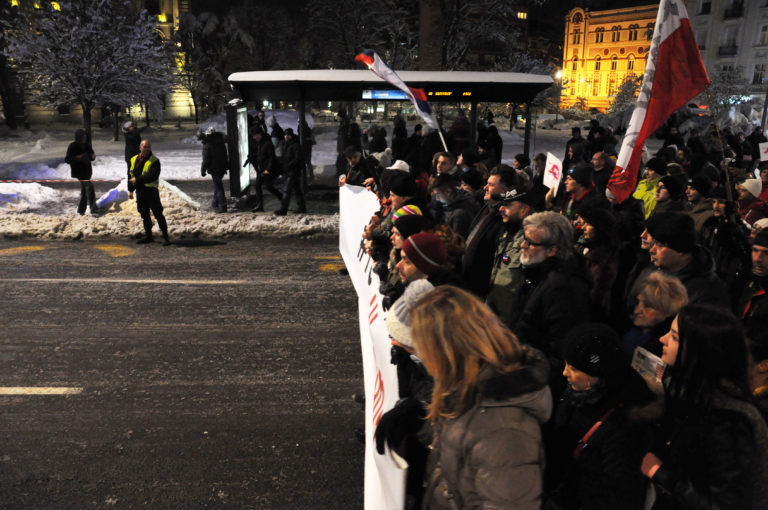
Whereas at first it seemed like everyone had their own frustration to voice — violence, corruption, media oppression, voter intimidation, difficulty in getting employment in the public sector without a party card, “stolen” pensions and falsified diplomas of certain ministers, among others — and thus also their own demands, the protestors have eventually managed to concretize the people’s dissatisfaction into one set of demands.
But between the first protest and this concretization the demands had underwent several stages of evolution. At the first massive rally people had hoped for the violence to stop, for the instigators of Oliver Ivanović’s assassination to be uncovered and arrested, as well as those of the assault on Borko Stefanović, and for the RTS network to report on all political options equally.

Three days before the second protest, however, journalist Milan Jovanović’s house was set on fire in what was and still is speculated to be another attempted murder. This event caused for an upgrade in the protestors’ demands so that, by the second rally on Dec. 15, 2018, they included the finding of whoever it was that executed and organized the attack on Jovanović.
Another occurrence that took place between the two protests, on the same day as the assault on Jovanović, was Aleksandar Vučić’s public comment regarding the number of protestors at the first rally.
“Here, let me explain what the trick is. They (the protestors) never take photos while standing, because they would then only be able to fit two and a half men wearing winter coats in one square meter, or three men in summer attire. But when they walk, one man can take five, six and seven square meters,” said the president. “And when there’s a thousand people you think — this is a miracle, this looks like a million people. Pay attention, they never take photos while standing, but only while they’re on the move.”
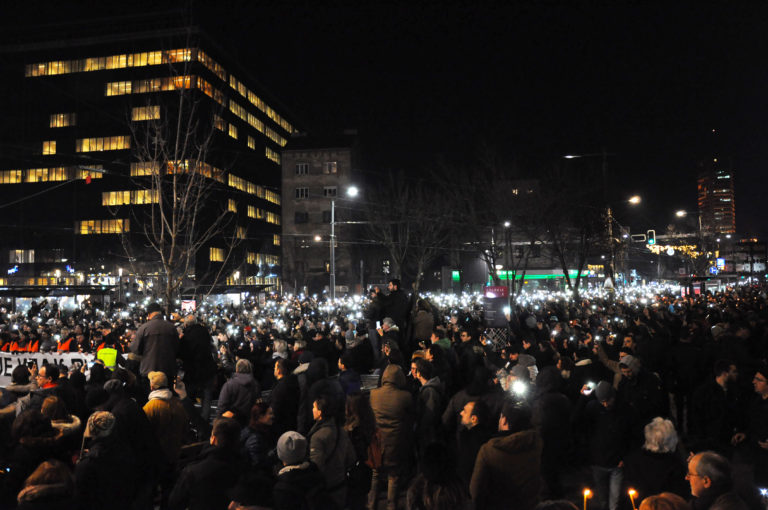
By the third rally the protestors had elaborated on their demand related to RTS. In an official letter, signed and presented by student Jelena Anasonović and actor Branislav Trifunović known to be the organizers of the protest, RTS was requested to dedicate five minutes of its over 30-minute-long news program “Dnevnik,” the most viewed informative program in the country, to a representative of the protest. They also requested for the network to publish the protestors’ demands and accurate data on their numbers.
“Radio Televizija Serbia (RTS) should be a public service for all citizens. Instead of that, RTS is an accomplice in the concealment of truth and the creation of a parallel, false reality that Aleksandar Vučić has been creating for six years already,” wrote the organizers.
Between the third and the fourth protest another event occurred that had resulted in nation-wide indignation, pushing the protestors to further develop their goals. Serbian Minister of Internal Affairs Nebojša Stefanović appeared at a press conference the day after the third protest and said that the rally was attended by 4,200 people. Using an A3 sized photograph of one moment of the protest which showed a section of the attendees, he spent around three minutes elaborating on his calculations.
The organizers, who had assessed that there were between 35,000 and 40,000 people at the third protest, added the resignation of Nebojša Stefanović to their list of demands and presented it at the fourth protest on Dec. 29, 2018, at which The Guardian estimated were around 25,000 people. For a cold, winter day in city of under two million people, this was a peculiarly significant turnout.
Apart from an unofficial request for RTS director Dragan Bujošević and “Dnevnik” editor Nenad Stefanović to be replaced, the fifth and sixth protest did not see any additions to the protestors’ demands.
By the seventh rally, the protests had official support from 105 professors and associates of the University of Philosophy in Belgrade.
Rather than to the ruling party, the demands at the seventh rally, held this Jan. 19, were presented to the opposition. The message read out to them just before the protestors began their walk was that the Serbian people demand a clear plan on how never to have a situation like today’s again, that they want to be led by “normal” people who are willing to do their job and that the opposition should do their best to earn the people’s trust.
The reason these were emphasized, also connected to why the protestors did not want to cooperate or have it appear like they’re cooperating with any of the opposing parties, was the fact that not one of the other existing parties was trusted by the public, not one was generally liked.
“We are here because we know we have to be. We walk for us, not for any politician or leader, not for the left, not for the right — for us,” said actor Trifunović addressing the crowd.
By the eight protest the list of university professors and associates supporting the protests evolved to 256 signatures, while between then and today it grew to 965. These now include the names of staff members from the University of Belgrade (Faculty of Organizational Sciences, Faculty of Economics, Faculty of Philosophy, Faculty of Philology), the University of Novi Sad, the University of Niš and from the University of Kragujevac.

Stability Versus Democracy
Today, as we enter the tenth consecutive week of protesting, the main demands stand sternly clear: The instigators of the assassination of Oliver Ivanović and those of the assaults on Borko Stefanović and Milan Jovanović should be taken into custody and revealed, RTS should find five minutes in its informative program “Dnevnik” to host a representative of the protest and should publish accurate data on the protestors’ numbers, and the Minister of Internal Affairs Nebojša Stefanović should resign.
Ultimately, as the former Supreme Court Judge Zoran Ivošević said in a speech before the last rally, “for Serbia to once again become a legal state, president of Serbia Aleksandar Vučić must resign.”
Considering the president’s attitude towards the protests and his “1 in 5 Million” statement, it seems highly unlikely that any of these demands will be met, even if he, at one point between the third and fourth rally, said he is ready to hear why these people aren’t satisfied. And even if one or two of the demands, other than the president’s resignation, end up being met, whether or not these changes will actually change enough on a greater scale remains questionable.
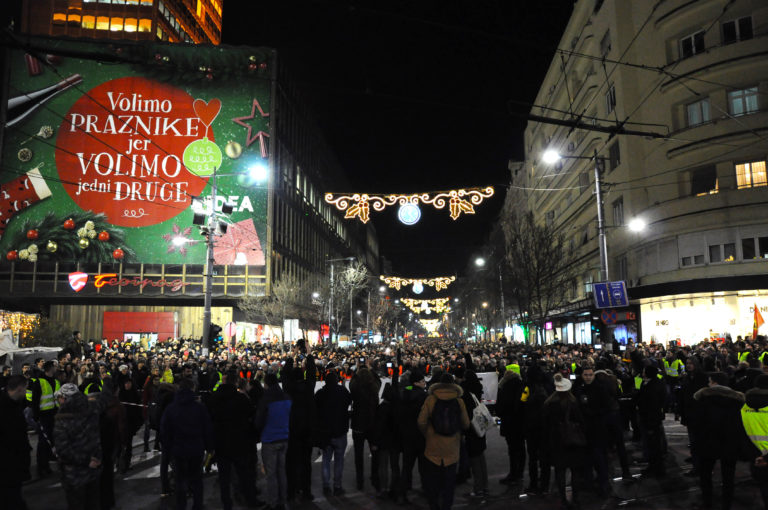
Perhaps what’s more important in the long run than these demands being met is the implication of the protestors’ scale and persistence — the implication that the people are there, that they’re frustrated, dissatisfied, that they’ve been played and deceived by their own government for long enough and that they now want and need change; that even the non-regime journalists and media representatives are ready to fight knowing that, in the words of Freedom House editor, Shannon O’Toole, “they could face intimidation or become the target of smear campaigns, or even experience physical violence as a result of their work.”
A snap election, which Vučić recently claimed he’s ready to take, could hardly be more than counter-productive if held under the current circumstances. The degree of influence that the governing party has on the local media is greater than ever and the opposition parties, even though they’ve recently united into an alliance, still have significantly less support. With only a segment of those who oppose the current regime supporting and trusting the opposition, the void between those disproving of Aleksandar Vučić’s rule and those supporting the opposition is simply still too wide. A snap election at this stage would only benefit the ruling party.
“Citizens and opposition parties,” began former professor Čedomir Čupić in his speech just prior to the eight protest, “need to stand together in order to deliver on the fundamental demand of these protests, which is the resignation of Aleksandar Vučić.” He then added that the only alternative to his resignation is his replacement.
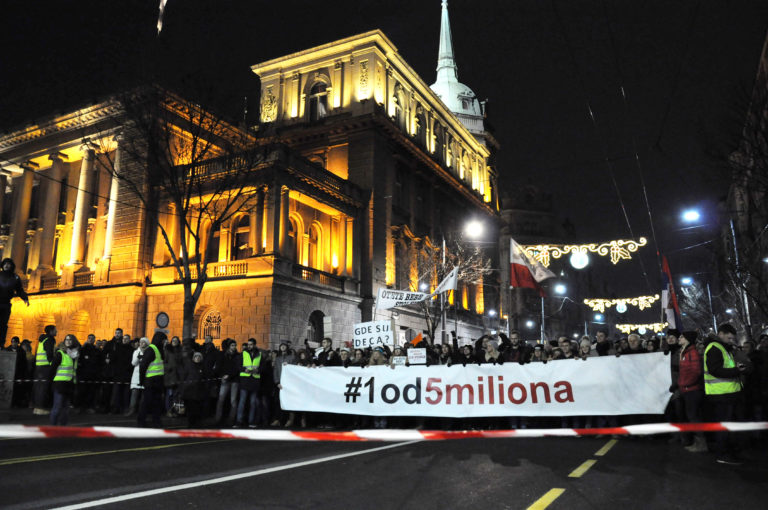
The protests of 2017 can attest to how much the dissatisfied people can achieve by themselves, without any political backing. Looking back at them, one could conclude that lest all the opposition to Vučić and his party are channeled into one direction by the next scheduled election in 2020, achieving the fundamental goal of these protests will be difficult.
Whether this cohesive direction would be the recently formed opposition alliance, which at present seems the most realistic, or a new political party remains to be seen — as do the answers to other questions upon which the long-term outcome of the protests will depend, questions such as: Will the opposition manage to earn the public’s trust despite falling victim to ceaseless ridiculing by practically all widespread local media? Will the representation of political parties in the local media get closer to equal, perhaps as a consequence of pressure from the European Union, or will it continue the trend of becoming less and less just? Will the EU — until now silent as a result of having given priority to “stability over democratic values” in the region, according to a report from the British House of Lords — lose interest in tolerating Vučić? Will the 2020 elections be fairer? Will they be better regulated?
Though some of the protestors’ demands, if met, are meant to have a positive impact on the answers to these questions, there is no certainty that they would in practice. Similarly, the negligence of the demands — even if it signifies that things will most likely remain as they are or become somewhat worse — doesn’t necessarily mean that the ultimate aim of replacing Aleksandar Vučić cannot be achieved.
Editors Note: The opinions expressed here by Impakter.com columnists are their own, not those of Impakter.com — In the Featured Photo: Protestors at the eight 1 in 5 million rally, Belgrade, Serbia, Jan. 26, 2019. Featured Photo Credit: Andrej Pavićević


